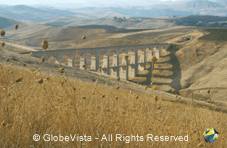Brief History
 Agrigento is located on a plateau overlooking the Mediterranean Sea on Sicily’s southern coast and surrounded by two rivers,the Hypsas and the Akragas. Agrigento was founded in 582 BC by a group of colonists from Gela (who were the immediate descendants of Greeks from Rhodes and Crete) and was named Akragas.
Agrigento is located on a plateau overlooking the Mediterranean Sea on Sicily’s southern coast and surrounded by two rivers,the Hypsas and the Akragas. Agrigento was founded in 582 BC by a group of colonists from Gela (who were the immediate descendants of Greeks from Rhodes and Crete) and was named Akragas.
However, a half a million-year-old female skull (“girl of Mandrascava”) was unearthed near Cannatello, evidence that the area had been inhabited long before the Greeks. The town was destroyed by the Carthaginians in 406 BC but was eventually rebuilt.
Akragas was renamed Agrigentum by the Romans after being conquered in 3rd century BC and was later renamed Girgenti after being conquered by the Saracens (Arabs). The Arabs arrived in AD 828 and began to develop settlements on the hills where the modern city now stands.
The area of the temples fell into decline and was soon abandoned. In 1401 the Temple of Zeus collapsed. In 1927 following the unification of Italy the city was finally christened Agrigento.
Things You May Not Know About Agrigento
 The local specialty is jasmine or almond flavoured granita.
The local specialty is jasmine or almond flavoured granita.
The Valley of the Temples is listed as a World Heritage Site.
Outside the Temple of Juno, you can find the remains of a sacrificial altar.
Now you might not know this, but Agrigento has one of the oldest hypogea, dating back to the 6th century BC. And what would that be? The hypogea, which are underground chambers, consists of a system of tunnels, channels, tanks and cisterns.
Agrigento was the home of Empedocles the philosopher who believed that matter was divided into four elements Earth, Air, Fire and Water.
The 1934 Nobel literature prize winner Pirandello (1867-1936) was born in Agrigento and his ashes are buried under a pine tree at his family home, known as “Il Caos”.
The town of Sciacca which is about 65km from Agrigento is the home of Italy’s oldest spa, found in the “steaming” caves on the slope of Monte San Calogero. It also has an Enchanted Garden in a small section of forest, created by Filippo Bentivenga, where he has carved masks into the tree trunks. As you wander through the forest you are greeted by hundreds of faces staring back at you.
